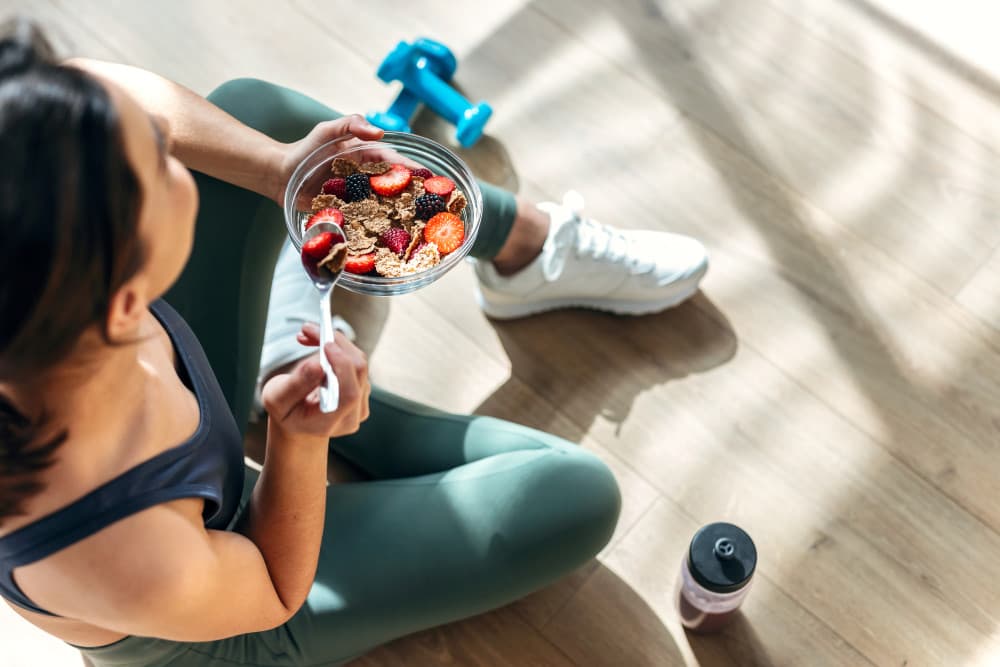Eating for Energy: How to Keep Your Energy Up and Avoid “Food Coma” from H-E-B Dietitians

6 Minutes

Team Curative

Apr 22, 2024
Are you tired of feeling sluggish and lethargic throughout the day? We asked our partner and expert H-E-B dietitian Mary Katharine Hutchinson MS, RDN, LDN to guide us on the best foods and combinations of foods to help keep you feeling energized. In this blog, we’ll cover valuable information about meal and snack frequency, the importance of pairing carbohydrates with proteins or fats, and discover recommended snacks for sustained energy without relying on sugary options. Plus, you’ll receive practical tips on portion control and strategies to gauge appropriate portion sizes. Say goodbye to feeling deprived while achieving your energy goals. Are you ready to kick-start your energy levels? Let's dive in!

Maintaining Energy Levels
Written by Mary Katharine Hutchinson MS, RDN, LDN
What foods or combinations of foods can help boost energy levels throughout the day?
Our energy levels are closely tied to our food intake and hydration levels. To keep energy levels up you’ll want to be mindful of meal and snack frequency as skipping meals can lead to feelings of low energy. Eating patterns and meal frequency are different for everyone, but if a patient complains of low energy levels, one of the first things I evaluate as a dietitian is their eating patterns. If you aren’t sure what might work best for you, a good pattern to start with is 3 meals and 1-2 snacks per day.
Next, I focus on a combination of foods to maintain and boost energy levels. Be sure carbohydrate sources are paired with a protein or a fat source. This combination of foods usually results in a more even blood sugar rise and fall which can support more sustained energy levels.
Are there recommended snacks for sustained energy without relying on sugary options?
Energizing snacks should also consist of a combination of carbohydrates and protein/fat. I often advise my patients to divide their snacks into two parts: choose a carbohydrate source rich in fiber and pair it with a source of protein or fat. These combinations can include options like fruit and almonds, crackers and a cheese stick, or cut vegetables and hummus. Additionally, there are excellent products available that already incorporate this essential combination of macronutrients, such as Greek yogurt with fruit, protein-rich granola bars, or trail mixes containing dried fruit. When selecting snacks, it is important to review the nutrition facts panel for options with no added sugar or those that contain less than 10% of the daily value for added sugar.
Portion Control
Written by Mary Katharine Hutchinson MS, RDN, LDN
How can individuals practice portion control without feeling deprived?
When it comes to reducing or controlling portions, you’ll want to ensure those portions are made up of satisfying foods. If we are eating smaller portions of foods that lack protein, fiber, or fat we are likely to feel deprivation that stems from hunger. Similarly, if we are eating smaller portions of foods that don’t taste good to us or that don’t bring us joy, we will feel deprivation that stems from emotion.
Another thing to keep in mind is that portion control is individual; there is no single portion size that is right for everyone. But there are serving recommendations. Taking an intuitive approach to portions is best, meaning the portions you select should leave you feeling fueled and satisfied. Deprivation is often what stands in the way of patients making lifestyle changes. It’s helpful to be mindful of when you may be feeling deprived and work with your dietitian to address those feelings.
Are there visual cues or strategies to help people gauge appropriate portion sizes?
I like to teach my patients about portion control with both visual cues and hunger cues. Patients can use their hands as a starting place for establishing portion sizes. Your palm can be used for proteins, your fist for fruits, grains and starches, your 2 palms put together for non-starchy vegetables, and your thumb for fats. Hands are an individual approach to establishing portion sizes, but it's important to also be mindful of your hunger and fullness cues after a meal. Generally, if you are hungry within a couple of hours of eating a meal it's possible you did not eat enough or include satiating macronutrients like fiber, fat, or protein. And if you are feeling uncomfortably full after a meal it’s possible your portions were too large. Start with your hands and layer on your hunger and fullness cues to gauge what the right portion sizes are for you. If you need some support in this process, schedule time with a dietitian.

Reducing Sugar Consumption, Hidden Sugars
Written by Mary Katharine Hutchinson MS, RDN, LDN
What are the potential health impacts of consuming too much sugar, and what alternatives do you recommend?
Consuming too much sugar can result in excess calorie intake, which can influence weight gain, inflammation, and increase your risk for developing chronic diseases. It can also displace the intake of other valuable nutrients. For example, if we opt for a couple of cookies or a soda as a snack rather than something more nutritious, like whole grain crackers and peanut butter, we are missing out on nutrients like fiber and protein.
There are a lot of safe alternative sweeteners on the market, and it’s really a matter of taste preference. The category of alternative sweeteners can be split into natural and artificial. Examples of natural alternative sweeteners include stevia, monk fruit, and sugar alcohols like erythritol or maltitol. Examples of artificial sweeteners include aspartame, sucralose, and saccharine. No matter the source, these can all help reduce added sugar intake. If you find that you don’t like any alternative sweeteners, you can look for products with less added sugar (less than 10% DV for added sugar) and modify your cooking or baking to include less sugar.
Can you suggest flavorful and healthy alternatives to sugary beverages that people can easily incorporate into their routines?
Beverages often contribute a large amount of sugar to the diet. It’s best to limit our sugar sweetened beverage consumption and reserve our added sugar intake for foods that will also provide macro and micronutrients. Thankfully, there are lots of ways to flavor your beverages without all the sugar. If you like the bubbles of soda, try swapping to plain or flavored sparkling water. Try adding citrus, herbs, cucumbers, other fruits, or a splash of 100% fruit juice to your water. I encourage patients to start with the option that sounds best to them and explore until they find a lower sugar beverage option that they enjoy.
What are some common hidden sugars?
Sugar is a type of carbohydrate, along with starches and fiber. Sugar is broad term that includes naturally occurring sugar and added sugar. When looking for sugar in a product, you can look at the total sugar and added sugar lines on the nutrition facts panel. In addition to the nutrition facts panel, you can reference the ingredient list where manufacturers are required to list all ingredients regardless of amount. Some common forms of sugar include: cane sugar, anything that ends in sugar, syrups, honey, agave, molasses, and fruit juice/puree/concentrate. Some more obscure forms of sugar include: lactose, sucrose, glucose, dextrose, fructose, and maltose. Prioritizing diet and hydration can have a significant impact on your energy levels and overall well-being. By being mindful of your meal and snack frequency, focusing on balanced food combinations, practicing portion control, and being aware of hidden sugars, you can make informed choices to support sustained energy throughout the day. Remember, small changes in your eating habits can lead to big improvements in how you feel. So, take charge of your energy levels and make the necessary adjustments to fuel your body for success. Here's to a healthier, more energized you!
If you’re a Texas-based Curative member and would like more information on your H-E-B benefits, please see our H-E-B Wellness Nutrition Services page. If outside of Texas and seeking nutritional services, please contact your Care Navigator.
Sign up for our Newsletter
Índice de Contenidos
Maintaining Energy Levels








